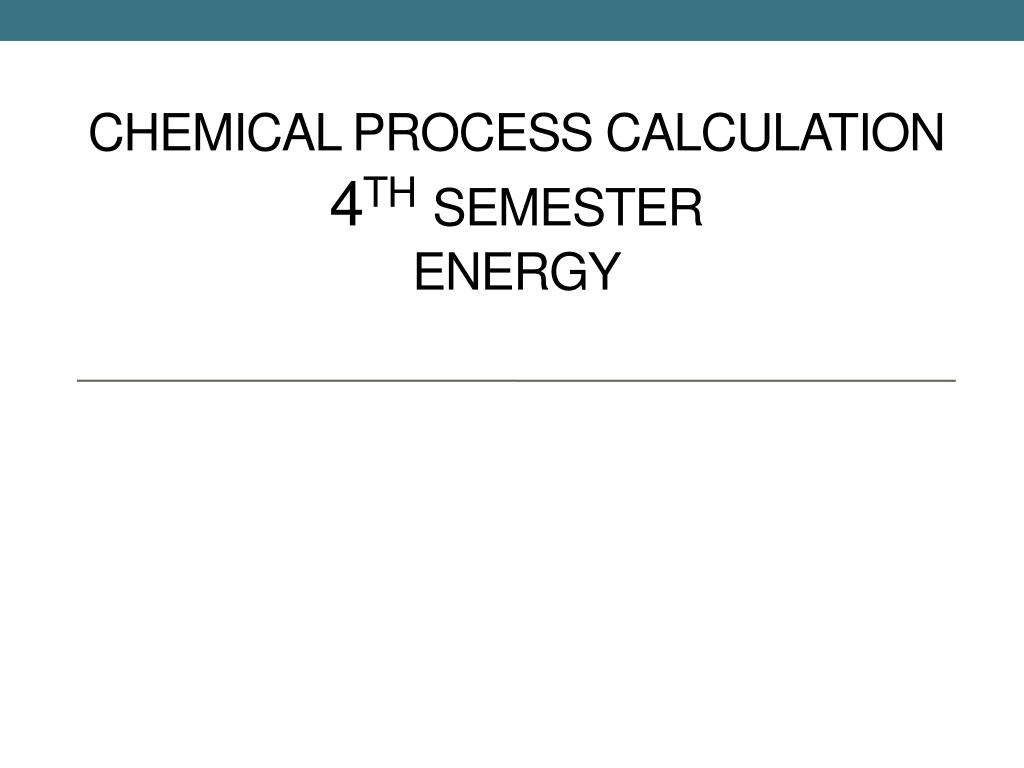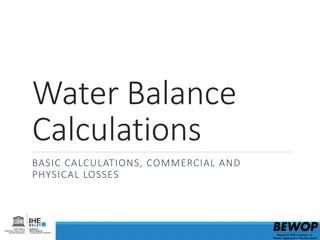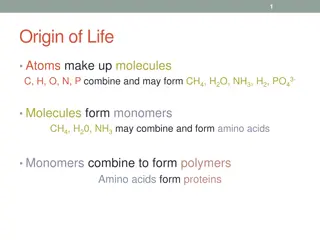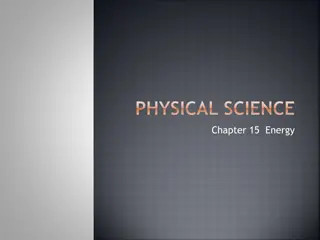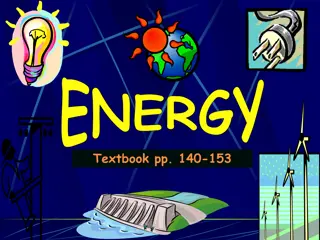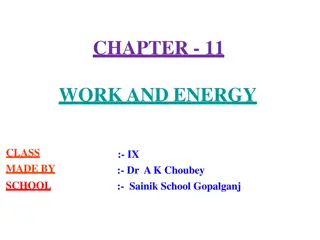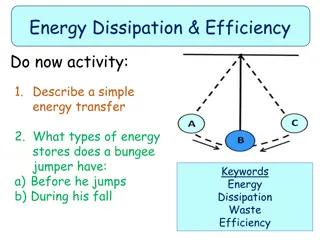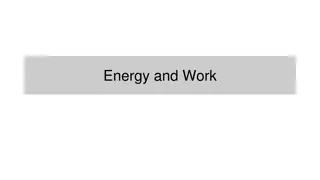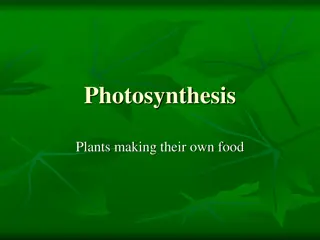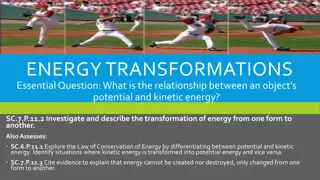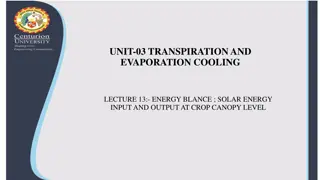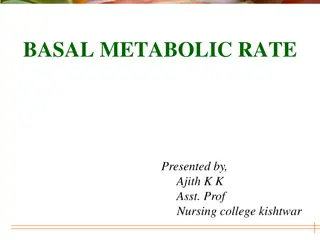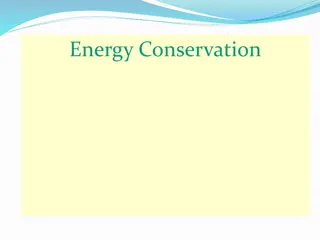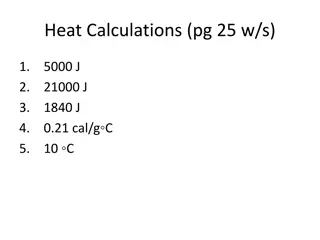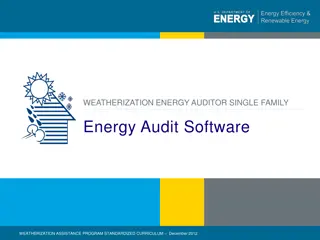Understanding Energy Balance in Chemical Process Calculations
Energy balance in chemical process calculations involves determining the energy requirements of a system by accounting for energy flow into and out of each unit. This includes defining terms like system and surroundings, distinguishing between open and closed systems, and understanding different processes such as isothermal, isochoric, isobaric, and adiabatic. The general steady state energy balance equation for closed systems is crucial for calculating net energy transferred.
Download Presentation

Please find below an Image/Link to download the presentation.
The content on the website is provided AS IS for your information and personal use only. It may not be sold, licensed, or shared on other websites without obtaining consent from the author. Download presentation by click this link. If you encounter any issues during the download, it is possible that the publisher has removed the file from their server.
E N D
Presentation Transcript
CHEMICAL PROCESS CALCULATION 4THSEMESTER ENERGY
Energy Energy may be defined as the capacity of the system for doing work. It may be generated by various methods. One of the methods of generating energy is by burning of fuels. According to the physical state, the fuels are available in the form of solid, liquid and gas. Some examples of solid, liquid and gaseous fuels are coal and wood, petrol, diesel and kerosene, LPG and natural gas respectively. The method of accounting of energy for the system is called energy balance.
Energy Balance Involves calculation for energy that flows into and out of each process unit in order to determine the overall energy requirement for the process. Fuel combustion is the main source of thermal energy in process industries. Sun, wind, water falls and nuclear power are other sources of energy.
Basic Concepts and Definitions its important to define several terms which will be commonly used in energy balance calculations: 1. System and Surroundings The system is any portion of apparatus enclosed by a real or imaginary boundary chosen for study. Every think outside the system boundary is termed as surroundings
If mass is not transferred across the boundary the system is termed as close system or non flow system If material continuously enter and leave the system across the boundary the system is termed as open system or flow system
2. Process Its is operation or a series of operations done on system to change its form from one state to another. The most common processes are : a. Iso thermal: Is the process carried out under constant temperature. b. Iso metric (Iso choric) : Is the process carried out under constant volume. c. Iso baric : Is the process carried out under constant pressure. d. Adiabatic: the process take a place in which no heat transferred between the system and its surrounding Q=0 .
General Steady State Energy Balance Equation A system in which no mass transfer but energy transfer may take place is called a closed system. The energy balance equation for closed system is given by: Final energy of the system Initial energy of the system = Net energy transferred to the system .(*)
where Final energy of the system = U2 + Ek2 + Ep2 Initial energy of the system = U1 + Ek1 + Ep1 Net energy transferred = Q W Q is heat transferred to the system and W is work done by the system. We take heat lost to surroundings as ve and heat transferred to the system as +ve. Substituting above eq. in in eq.(*), we get (U2 U1) + (Ek2 Ek1) + (Ep2 Ep1) = Q W At steady state, there is no accumulation of energy. Therefore, Input energy Output energy = 0 Input energy = Output energy
Energy Balances on Open Systems A system is open if mass crosses the system boundary. For such a system, work must be done on the fluid mass to push it into the system and work is done by the fluid mass exiting the system. These two constitute the flow work and should be included in the energy balance. Work could also be done by the fluid mass on moving parts of the system (example: steam driving a turbine). The majority of chemical reactions proceed at constant pressure, hence the work performed by chemical reaction is PV. Therefore, the heat exchanged during the course of reaction is equal to the change in enthalpy. The heat exchanged for chemical reactions proceed at constant volume is equal to the change in internal energy. The enthalpy and internal energy are related through the equation:
H = U+ PV H: is rate of change of enthalpy (kJ/mole). PV = Change in work performed (kJ/kg). Since (PV ) is very small as compared to H and U. Hence, it may be neglected. In this case, it may be written as: H = U Therefore energy balance equation: H + Ek + Ep = Q W Q: is rate at which energy is transferred to the system W: is the rate at which work is done by the fluid on the system.
It is not possible to know or estimate the absolute values of internal energy and enthalpy. We need to find only the change in these properties to make an energy balance. Enthalpy and internal energy of species could be tabulated with respect to a reference state (temperature, pressure and phase).
Example: Saturated liquid water is cooled from 80F to 40F still saturated, what are E, U, H, P. and V? Solution The properties below are from steam tables for saturated liquid at its vapour pressure At initial condition 80 F P= 0.5067 psia V= 0.01607 ft /lb H = 48.02 Btu/lb
At final condition 40 F P= 0.1216 psia V= 0.01602ft /lb H = 8.05 Btu/lb Then P= Pf Pi = 0.1216 - 0.5067 = - 0.385 V= Vf Vi = 0.01602 0.01607 = negligible value H= Hf Hi = 8.05 48.02= -39.97 Btu/lb W= 0 Ek= 0 Ep= 0
Now H = U+ PV U= H PV PV = P2V2 P1V1 = 0.1217* 0.01602 0.5067 * 0.01607 = 0.001141 negligible value Thus U= H= -39.97 Btu/lb
